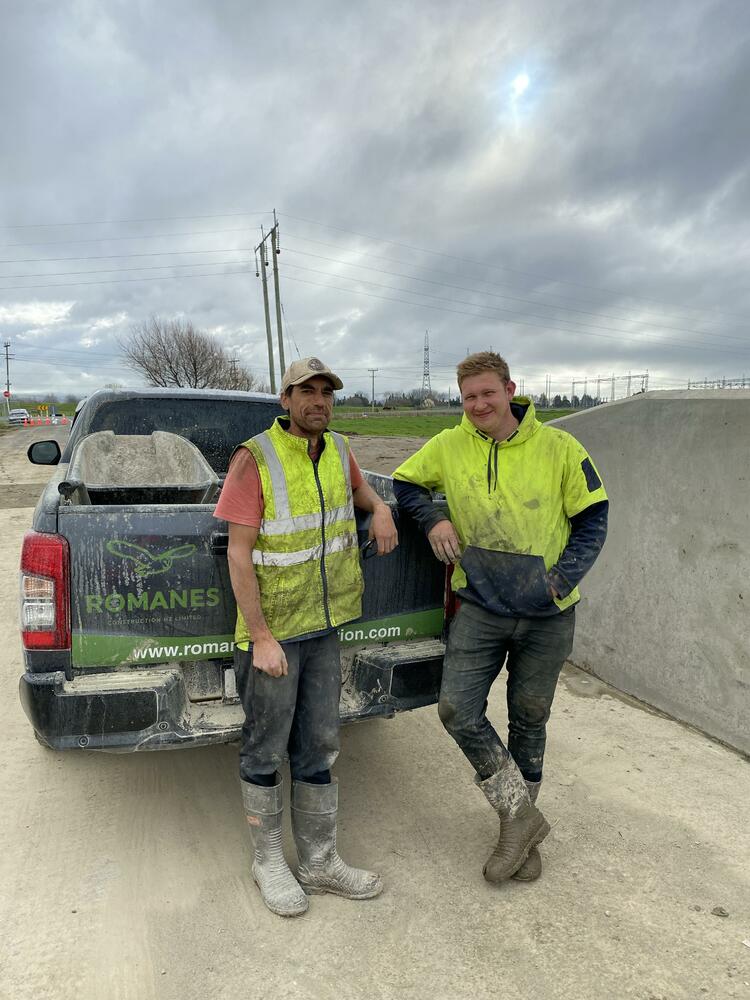When taking on a project, Managing Director of Romanes Construction, Paul Romanes, always looks to employ locals to be part of his crew.
“It’s an important part of our business model. It always has a positive flow-on effect – from the large crew we hire, there are stand-outs, and those people tend to become part of our regular crew for project after project. They’re also more likely to hire other locals for their own projects.”
When it comes to the benefits of a local team, Paul says there are many: “Local employees know the area, they know the people and know good suppliers. They also have a real pride in their place; we’ll often hear of them popping down the road to the work site, making sure it is tidy and that the equipment isn’t getting destroyed in the elements.”
The construction company has partnered with Bay of Plenty Regional Council on both the construction of the Kaituna Mole and the final stage of the Rangitāiki Floodway – two jobs which aligned well to Paul’s company ethos.
Both projects are part of the Climate Resilience Programme, a joint initiative between Kānoa (the Regional Economic Development and Investment Unit), regional councils and the community focused on developing and upgrading vital river management and flood protection schemes in Aotearoa.
These two projects attracted Kānoa funding for their ability to support new and existing local employment opportunities, and help grow local sectors impacted by Covid-19, for a more productive, sustainable, resilient regional economy.
The final stage of the Floodway is the installation of two sets of swing gates across two roads (McCracken and McLean) near Edgecumbe. To construct the gates, it involves cutting into the road to create a new concrete pad. They then set up two concrete walls at each site for the gates to attach to (the steel gates were made off-site by Page Macrae and were brought in when the concrete work was done).
The design of this swing gate system is unique to New Zealand – while stoplogs and sliding gates are commonplace, hinged gates across a road are the first of their kind.
In a flood event, these swing gates will act as a barrier on the road, keeping cars from entering a flood zone, and maintain the stopbank height of the Floodway, creating a channel that will help send water out to the Rangitāiki River mouth.
Sub-contractor Tim Walters (Te Arawa) has worked with Paul on both Kaituna and Rangitāiki River projects, along with his brothers, Justin and Tom, cousin Kaia and neighbour TK. The Maketū local had been working in Australia on form work construction and returned home to New Zealand in 2018. He met Paul when he was recruiting local iwi to be involved in the Kaituna Mole construction.
“We had about six of us from Maketū get involved, all with different levels of experience, which was good as we could help build up the younger fellas.
“Being from Maketū it was a project I wanted to be part of, so I could go down there with my son and tell him, ‘Yeah, I built this’.”
When Paul secured the contract for the Rangitāiki job, he gave Tim a call to come and carry on working together. While it’s 40 minutes away from Tim’s home, it’s like another home to him, as his partner and her whānau have strong connections to the area.
“Her grandfather was Bill Kerrison, the ‘kaitiaki of tuna’ in the East, so although this is a different site, the Bay of Plenty is a small community where everyone knows everyone.
“For me and the other guys working on the site, it feels special to be part of these kinds of projects when you know what the purpose of it is – to help protect the people. We really enjoy it.”
Tim says there are plenty of advantages when it comes to locals working on local projects, particularly the pride that is put into them.
“Bringing in people who know the area, who know the people, is important. It gives the community peace of mind about who is working in their backyard as they know they will respect the place that they are working in.
“It’s also a great way to get the word out what’s happening, and encourage other locals to get involved and employed on these jobs.”
Paul says he is really enjoying the Rangitāiki project and he’s got a great team around him.
“Our crew have gelled together really well and we really enjoy working with Regional Council. The boys (Jordan and Peter) are straight-up when it comes to supporting local business and we’ve built a really good relationship.”
Bay of Plenty Regional Council received $10.28M for the Rangitāiki Floodway and Spillway, and $1.63M for the Kaituna Mole from Kānoa.
